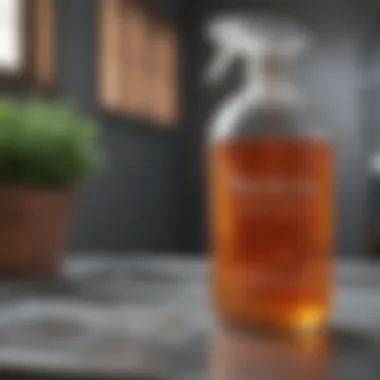Harnessing Vinegar: A Game-Changer in Laundry


Intro
Vinegar is not just a culinary staple. Its capabilities extend into the realm of laundry. This article explores the chemical properties of vinegar and how they can transform laundry practices. From deodorizing fabrics to enhancing cleaning efficiency, vinegar offers numerous benefits. By understanding these aspects, homeowners can make informed decisions about their laundry routines while embracing eco-friendly methods.
In the following sections, we will discuss the practical applications of vinegar in laundry, including usage techniques and potential risks. The focus remains on a systematic approach to utilizing vinegar effectively, making it a versatile tool for anyone aiming to improve their laundry outcomes.
The Chemical Properties of Vinegar
Vinegar primarily consists of acetic acid, usually at a concentration of 5-20% when diluted with water. This acidity is what makes it effective in dissolving mineral deposits, cutting through grease, and neutralizing odors. Here, we break down its key characteristics:
- pH Level: The acidic nature of vinegar gives it a pH level of around 2-3, which works wonders in breaking down stains and residues on fabrics.
- Natural Antimicrobial: Research indicates that vinegar can inhibit the growth of certain bacteria and mold, making it helpful in minimizing germs in laundry.
- Water Softening: Vinegar can help soften hard water, which often leads to buildup in washing machines and decreased effectiveness of detergents.
Benefits of Using Vinegar in Laundry
Utilizing vinegar in laundry can yield multiple advantages, reinforcing it as a favored choice for many:
- Odor Elimination: Vinegar is a natural deodorizer, effective in tackling stubborn smells embedded in fabrics.
- Stain Removal: It can penetrate fabric fibers and lift stains, making it easier to remove dirt and grime without harsh chemicals.
- Fabric Softening: Serving as a natural fabric softener, vinegar leaves clothes feeling soft and reduces static cling.
- Eco-Friendly: Vinegar is biodegradable and non-toxic, making it an environmentally conscious cleaning solution.
"Incorporating vinegar into your laundry regimen promotes a sustainable approach to household cleaning."
Practical Applications of Vinegar in Laundry
The practical usage of vinegar in laundry is straightforward. Here are some effective methods:
- As a Fabric Softener: Add 1/2 to 1 cup of distilled white vinegar to the rinse cycle of your washing machine. This will enhance softness and freshness without harmful chemicals.
- Stain Treatment: Apply undiluted vinegar directly onto the stain. Let it sit for at least 30 minutes before washing.
- Odor Neutralization: For musty or smoke-smelling fabrics, soak them in a solution of water and vinegar for an hour before washing.
- Machine Maintenance: Periodically run an empty load with a mixture of vinegar and water to help clean your washing machine and reduce odors.
Potential Risks and Considerations
While vinegar is beneficial, there are some considerations:
- Fabric Sensitivity: Certain fabrics, like silk or acetate, may not respond well to vinegar. It's essential to test on a small area first.
- Caution with Other Cleaners: Mixing vinegar with bleach or ammonia can create harmful gases, so avoid doing this.
- Colorfastness: Always check if fabrics are colorfast before using vinegar to prevent color fading.
The efficacy of vinegar as a laundry aid emerges from its simple yet potent chemical properties. As we move forward, we will delve into alternative methods and solutions that can further enhance laundry practices.
Prolusion to Vinegar in Laundry
The integration of vinegar into laundry routines is emerging as an invaluable practice, particularly for homeowners and those concerned with eco-friendly cleaning strategies. This section elucidates the significance of vinegar in laundry management, examining its multifaceted benefits and considerations. Primarily known for its versatile uses, vinegar, especially white distilled vinegar, stands out in addressing common laundry challenges such as stubborn odors, fabric care, and stain removal.
Vinegar has been utilized for centuries, and its acceptance in contemporary laundry practices is bolstered by an increasing trend toward natural cleaning methods. As we explore the historical context, we find that vinegar not only cleans but also conditions fabrics without the harmful chemicals found in many commercial products. Furthermore, the relevance of vinegar today cannot be overstated; it serves as a cost-effective alternative while promoting sustainable living choices.
Overall, understanding the role of vinegar in laundry provides a framework from which one can improve laundry results and care for fabrics more effectively.
Historical Context
Vinegar's history stretches back thousands of years, with ancient civilizations like those of Babylon and Egypt using it for various purposes, including preservation and cleaning. The use of vinegar as a cleaning agent draws upon its acidic nature, which is effective in breaking down dirt and grime. In the 19th century, it became common in households for multiple cleaning needs, including laundry. Over time, as synthetic detergents emerged, the popularity of vinegar in laundry diminished, yet it remained a staple in some households that valued natural cleaning solutions.
This historical backdrop demonstrates that vinegar is not merely a fad but a practical solution rooted in tradition. Today, it attracts attention again due to growing concerns about environmental sustainability and health hazards linked to some commercial detergents.
Current Relevance
As we navigate modern living, the relevance of vinegar in laundry is particularly pronounced. The demand for eco-friendly cleaning alternatives is on the rise, with consumers becoming more aware of the potential dangers associated with chemical residues left on fabrics and in the environment. Vinegar serves as a natural solution that addresses these concerns effectively.
Moreover, vinegar’s effectiveness in eliminating odors and stains has made it a favorite among homeowners looking for practical, low-cost solutions. Its wide availability in stores also adds to its appeal. Now, householders can easily grab a bottle during their routine shopping, making the transition to vinegar utilization in laundry seamless.
"Vinegar is not just a condiment; it is a powerful tool for effective laundry care that emphasizes both environmental responsibility and cost savings."
In summary, vinegar's enduring historical context and its current ascendancy as a practical laundry aid highlight its significance. Homeowners seeking effective, safe, and economical methods for maintaining their laundry will find vinegar to be a deserving candidate in their cleaning arsenal.
Chemical Properties of Vinegar
Vinegar is not just a kitchen staple; its chemical properties play a significant role in its effectiveness in laundry applications. Understanding these properties is essential for homeowners looking for efficient and eco-friendly cleaning solutions. The primary active ingredient in vinegar is acetic acid, which is responsible for many of its beneficial effects in laundry routines.


Acetic acid can effectively break down mineral deposits, making it a useful agent for managing hard water issues, which are common in many households. Additionally, vinegar has the ability to neutralize odors and can tackle stains, providing a versatile solution for cleaning needs. Also, its natural composition means it is less harmful to the environment compared to many commercial cleaning products.
Acetic Acid Composition
Acetic acid is the key component in vinegar, typically making up about 5-20% of the volume, depending on the type of vinegar. This organic compound gives vinegar its characteristic sour taste and strong smell. When it comes to laundry, acetic acid acts not only as a mild disinfectant but also as a leaching agent that can penetrate fabric fibers to lift stains.
Unlike harsh chemicals often found in many cleaning products, vinegar is gentle on fabrics. However, it is essential to recognize that some fabrics, particularly delicate ones, may not react well to vinegar. Thus, it is advisable to test a small area before full application.
pH Levels and Their Effects
The pH of vinegar typically ranges from 2 to 3, indicating its acidic nature. This acidity plays a crucial role in a variety of cleaning processes. When it comes into contact with basic substances, such as alkaline stains or hard water deposits, vinegar can react chemically, allowing for easier removal of these unwanted elements.
- Odor Control: The low pH of vinegar helps in neutralizing odors that can linger on clothing, such as those from sweat, smoke, or mildew.
- Stain Treatment: For stains, the acidic environment that vinegar creates can break down organic materials, which makes it easier to wash them away.
- Fabric Brightening: Using vinegar may help in restoring the brightness of fabrics, acting as a natural whitener without the use of harmful chemicals.
"Understanding the chemical properties of vinegar enhances its usage in laundry, making it a formidable competitor to commercial detergents."
In summary, the chemistry behind vinegar's composition and pH levels not only aids in cleaning but also supports environmentally conscious practices in household management. Recognizing how acetic acid and pH function together provides valuable insights for anyone looking to elevate their laundry solutions.
Benefits of Using Vinegar in Laundry
Using vinegar in laundry presents various practical advantages that many homeowners may not fully appreciate. The benefits extend far beyond just a single use. Understanding its properties helps to enhance washing performance, address common laundry challenges, and promote an eco-friendly lifestyle. This section will detail three primary benefits: odor neutralization, stain removal, and fabric softening. Each benefit contributes not only to cleaner clothes but also to a more sustainable approach to laundry.
Odor Neutralization
One of the most notable benefits of vinegar is its ability to neutralize odors. Many fabrics can hold onto smells from sweat, cooking, and other sources, leading to unpleasantness. Vinegar, particularly white distilled vinegar, has acetic acid, which is effective in breaking down molecules responsible for these odors.
To use vinegar for odor neutralization, simply add a cup of it to your washing machine during the rinse cycle. This helps to eliminate stinks without leaving a vinegar smell on the clothes. It’s especially useful for items like gym clothes or kitchen linens. The process is simple and can be integrated easily into your regular washing routine.
Stain Removal
Another significant benefit of vinegar lies in its stain removal capability. When treated with vinegar, various stains can be removed effectively, be it grass, wine, or food products. Acetic acid works by dissolving residues and breaking down complex stain molecules, making them easier to wash away.
For best results, mix vinegar with baking soda to create a powerful paste. Apply this mixture to the stained area before washing. This combination acts as a mild abrasive, engaging with the stain while also making the fabric more receptive to washing.
"Vinegar's ability to tackle tough stains makes it a versatile addition to any laundry regimen."
Fabric Softening Properties
Lastly, vinegar is a natural fabric softener, providing a gentle alternative to commercial fabric softeners. Many commercial products contain synthetic chemicals that can irritate skin or wear down fibers over time. Vinegar, on the other hand, conditions the fibers in fabrics, making them softer and reducing static cling.
Adding a cup of vinegar to the final rinse cycle can help maintain the softness of clothes without introducing harsh chemicals. It not only softens cottons and blends but can also help to maintain the integrity of towels, pillows, and blankets. Regular use may extend the lifespan of these fabrics while ensuring they remain fresh and pleasant against the skin.
In summary, utilizing vinegar in laundry offers substantial benefits, encompassing odor neutralization, stain removal, and natural fabric softening. These capabilities highlight vinegar as a valuable, eco-conscious addition to laundry practices, improving the overall outcome of cleaning without adding costs or risks associated with many commercial products.
How to Use Vinegar in Laundry
Utilizing vinegar in laundry is a time-tested method that addresses multiple challenges faced by householders. Its ability to neutralize odors, soften fabrics, and tackle stains is not just anecdotal but backed by science. Understanding how to implement vinegar effectively can significantly enhance laundry outcomes while being mindful of fabric care and environmental considerations.
Pre-treatment of Stains
One of the most effective uses of vinegar in laundry is as a pre-treatment for stains. Prior to washing, applying a mixture of vinegar and water directly to the stained area can break down the stain's composition. This application works particularly well for organic stains like those from food and body oils.
- Formula: Use a ratio of 1 part white vinegar to 2 parts water.
- Method: Spray or dab the mixture onto the stain and let it sit for 5 to 10 minutes before laundering.
This process aids in loosening the stain. Keep in mind that applying vinegar to delicate fabrics like silk or wool may require extra caution. Testing on a hidden area is advised to avoid any potential damage.
As a Fabric Softener Alternative
Many homeowners search for ways to soften clothes without resorting to commercial fabric softeners, which may contain synthetic chemicals. Vinegar serves as a natural softening agent. Adding half a cup of white vinegar to the rinse cycle can leave fabrics feeling softer and fresher.
- Why it works: Vinegar breaks down detergent residues that can make fabrics feel stiff.
- Application: Pour the vinegar into the fabric softener dispenser of your washing machine, or during the rinse cycle in a top-loading model.


Its deodorizing properties can also help in eliminating lingering smells from washing. However, keep it away from fabrics that can react negatively with acidity.
Dealing with Hard Water
Hard water can lead to mineral buildup in fabrics and appliances, reducing cleaning efficiency. Vinegar can mitigate these effects. When added to laundry, it assists in breaking down mineral deposits.
- How to Use: Add one cup of vinegar during the rinse cycle to help remove residues left by hard water. This can lead to cleaner clothes and shinier appliances.
- Precautions: Though effective, frequent use of vinegar on delicate fabrics should be monitored to prevent any potential weakening over time.
Using vinegar in these various ways can enhance laundry routines, making them both effective and eco-friendly. Knowing how to apply vinegar gives homeowners better control over their laundry outcomes.
Considerations and Precautions
When incorporating vinegar into laundry practices, it is essential to consider various factors that ensure effective and safe usage. While vinegar offers numerous benefits in terms of stain removal, odor neutralization, and fabric softening, it is not without potential downsides. Understanding these considerations helps in avoiding unwanted damage to clothes and in maximizing the effectiveness of laundry routines.
Potential Damage to Fabrics
Vinegar may not be suitable for every type of fabric. While natural fibers, such as cotton and linen, generally handle vinegar well, synthetic fabrics like polyester and certain blends may react differently. Prolonged exposure to acetic acid can cause deterioration over time. For example, colors might fade, and materials could weaken. To mitigate this risk, it is advisable to conduct a patch test. Applying a small amount of vinegar solution to an inconspicuous spot can reveal any adverse effects before treating the entire garment.
Additionally, understanding the concentration of vinegar used is important. For instance, household white vinegar typically contains around 5% acetic acid. Using it at full strength on delicate fabrics may lead to damage or discoloration. Diluting vinegar with water—generally in a ratio of one part vinegar to three parts water—can help reduce the potential for harm while still providing benefits.
Avoiding Chemical Reactions
Another critical consideration involves the potential for adverse chemical reactions between vinegar and other laundry detergents or fabric care products. Vinegar, being acidic, can interfere with the effectiveness of alkaline-based products, like certain laundry detergents. Mixing these substances may lead to neutralization, resulting in less effective cleaning.
To avoid these reactions, it is best to use vinegar in separate washing cycles or at different times during the laundry process. For example, one could use vinegar during the rinse cycle, which allows for the benefits without interfering with the cleaning properties of detergent.
"Understanding the correct usage of vinegar can transform your laundry experience, preventing mishaps that could ruin favorite garments."
In summary, while vinegar is a helpful laundry aid, awareness of its limitations and proper usage is vital. By testing fabrics and using it judiciously, one can ensure that the advantages of vinegar enhance laundry routines without jeopardizing fabric integrity.
Alternative Uses for Vinegar in Laundry
The applications of vinegar in laundry extend beyond mere cleaning or fabric softening. Exploring these alternative uses allows homeowners to enhance their overall laundry experience, contributing to efficiency and prolonging the life of textiles. This section outlines how vinegar can be a valuable ally in maintaining a clean and fresh laundry environment.
Cleaning Washing Machines
A washing machine can accumulate residue, detergent buildup, and even odor over time. Regular cleaning is essential for optimal performance. Vinegar serves as an effective and eco-friendly solution to clean washing machines.
To clean your washing machine with vinegar:
- Fill the drum: Set the washing machine to the highest setting and add two cups of vinegar when the drum fills with water.
- Run a cycle: Allow the machine to run through a complete cycle, letting the vinegar work to break down any accumulated grime.
- Wipe down: After the cycle, use a cloth soaked in vinegar to wipe the interior walls and rubber seals of the machine.
- Rinse: Perform another cycle with just water to rinse away any remaining vinegar.
This not only cleans but also helps eliminate odors. Regular cleaning can ensure efficient operation and prolong the lifespan of the machine, making it a smart practice for any household.
Refreshing Old Towels
Old towels can lose their absorbency and begin to smell musty over time. Vinegar can revitalize these textiles, making them feel fresh again. This process is simple and efficient.
To refresh old towels with vinegar:
- Soaking method: Fill a tub with warm water and add one cup of vinegar. Allow the towels to soak for about 30 minutes. This helps break down residues that can hinder absorbency.
- Washing method: After soaking, wash the towels in a regular cycle with detergent and an additional cup of vinegar. This will remove odors and restore freshness.
Using these methods, towels can regain their softness and absorbent qualities, providing better functionality for everyday use.
"A solution that is both cost-effective and environmentally friendly can benefit laundry efficiency."
Utilizing vinegar for cleaning washing machines and refreshing towels emphasizes its versatility. These alternative uses tap into the chemical properties of vinegar while providing practical solutions for everyday laundry challenges.
Vinegar vs. Commercial Products
In recent years, the laundry industry has been inundated with various commercial products, each promising superior cleaning capabilities and fabric care. However, amid this wave of synthetic solutions, vinegar remains a remarkable alternative, often overlooked. Understanding the comparison between vinegar and these commercial products reveals significant insights into their respective roles in laundry.


The importance of dissecting this comparison lies not only in cost-effectiveness but also in the varying efficacy of products. Many consumers are unaware of the potential benefits vinegar offers in both practical uses and environmental stewardship. This evaluation will cover both the cost analysis and efficacy comparison, elucidating why vinegar can hold its own against commercial alternatives.
Cost Analysis
Cost is often a major consideration for households. When comparing vinegar to commercial laundry products, vinegar offers a clear financial advantage. A typical bottle of distilled white vinegar is markedly less expensive than branded detergents or fabric softeners. Consumers can purchase a large container of vinegar for a fraction of the price of its commercial counterparts. This aligns well with a trend towards sustainable living, where people aim to both save money and reduce their environmental footprint.
For example, a gallon of vinegar can cost around three to five dollars, whereas a comparable amount of commercial laundry detergent may range from fifteen to twenty-five dollars. An added bonus is the versatility of vinegar; its applications extend beyond just laundry, making it a useful product for cleaning, cooking, and more.
Efficacy Comparison
When considering efficacy, it's essential to recognize that while commercial products may tout powerful formulations, vinegar also serves effective purposes in laundry routines.
- Odor Neutralization: Vinegar has natural deodorizing properties, making it excellent at eliminating stubborn smells from fabrics. Commercial products range in their effectiveness, with some failing to completely eradicate odors.
- Stain Removal: Vinegar can break down residues and stains due to its acidic nature. While some commercial stain removers are effective, they often rely on harsh chemicals. In contrast, vinegar provides a gentler approach, aligning with eco-friendly practices.
- Fabric Softening: Using vinegar as a fabric softener alternative can produce softer laundry without the buildup of synthetic chemicals that some softeners leave behind.
Despite some skepticism regarding vinegar’s cleaning power, user testimonials often highlight its effectiveness. Some commercial products may be optimal for certain specific stain types, but vinegar adapts to a wide array of challenges presented in laundry.
Ultimately, the decision between vinegar and commercial laundry products boils down to personal preference and individual laundry needs. Cost efficiency and versatility of vinegar make it a worthy contender in the laundry space, offering a sustainable and effective alternative to many mainstream options.
Using vinegar in laundry not only saves money, but also promotes a healthier environment.
This in-depth analysis serves as an encouragement for homeowners and eco-conscious consumers to consider vinegar as a valuable asset in their laundry care arsenal.
User Testimonials and Insights
User testimonials and insights provide a wealth of real-world evidence regarding the effectiveness of vinegar in laundry. These accounts present a vast array of practical experiences that can inform and aid others seeking natural solutions for laundry challenges. The feedback from those who have incorporated vinegar into their laundry routines sheds light on both its efficacy and practicality. Such testimonials serve as a valuable reference point for individuals who may be hesitant to use unconventional methods for fabric care.
Experiences with Odor Elimination
Many users have reported significant success in eliminating unpleasant odors from garments and textiles using vinegar. This is especially true for items that are prone to absorbing odors, such as gym wear, towels, and bedding. Vinegar’s natural acidity helps break down the substances that cause odors, making it a strong candidate for odor removal without the potentially harmful chemicals found in commercial products.
For instance, one user shared their experience of tackling the lingering smell in their sports clothing. After a few washes with added vinegar, they noticed a remarkable difference. The musty odor was replaced with a neutral scent, showcasing vinegar's potential as an effective deodorizer. This account supports the assertion that vinegar can act efficiently, proving beneficial especially for those who prefer eco-friendly solutions.
Additionally, homemade remedies involving vinegar are often cited in community discussions. Many users recommend a specific method: adding half a cup of white vinegar during the rinse cycle, which has shown to yield favorable results. This method not only targets odors but also enhances overall freshness of washed items.
Stain Removal Success Stories
Testimonials about eliminating stains with vinegar are equally compelling. Users have shared various anecdotes on how vinegar has become a household staple for such purposes. It is particularly noted for its effectiveness against common stains from food and beverages, grass, or sweat.
One person recounted treating a stubborn red wine spill on a light-colored shirt. They applied a mixture of vinegar and water directly on the stain before laundering. To their astonishment, the stain faded significantly after the wash. This incident demonstrates vinegar's ability to act as a pre-treatment agent for stains, offering a cost-effective alternative to specialized products.
Moreover, several forums highlight collective stories regarding treating different types of fabric, from cotton to synthetics. This diversity in fabric types underscores vinegar’s versatility in stain removal across various materials. And as more users experiment with vinegar, it becomes increasingly clear that its application goes beyond simple washing; it addresses a multitude of laundry obstacles with commendable results.
"I never thought a simple kitchen staple could revolutionize my laundry game. Vinegar has not only helped me keep my clothes odor-free but has also assisted me in tackling stains head-on!"
These testimonials affirm that for homeowners, interior design enthusiasts, and anyone dealing with laundry challenges, vinegar presents a valid alternative to conventional laundry products, often at a fraction of the cost.
Culmination and Final Thoughts
In concluding this thorough exploration of vinegar in laundry practices, it's critical to understand the multifaceted benefits and implications of integrating this common substance into routine washing. One of the primary highlights is its effectiveness as a natural remedy for various laundry challenges. From eliminating stubborn odors to aiding in stain removal, vinegar stands out as both affordable and eco-friendly. Furthermore, its role in fabric care, particularly in softening and maintaining the quality of textiles, cannot be overlooked.
In addition to these positives, awareness of potential drawbacks is essential. While vinegar is generally safe for most fabrics, there are some exceptions. Understanding the limitations will allow users to enjoy the benefits without risking damage to their garments. It is crucial not to utilize vinegar with every cloth type or in every washing scenario since certain delicate fabrics may react negatively.
Ultimately, being informed about the comprehensive use of vinegar in laundry supports better decision-making among homeowners and associated audiences. Explore the practical implications of this natural ingredient and consider incorporating vinegar judiciously. By doing so, one can enhance both laundry outcomes and overall garment longevity.
Summarizing the Benefits
The advantages of using vinegar in laundry are numerous and varied. Here are the key benefits:
- Odor Neutralization: Vinegar effectively neutralizes unpleasant smells, making clothes fresher.
- Stain Removal: Many stains, such as food or sweat, respond well to vinegar's properties, improving cleaning outcomes.
- Fabric Softening: This acidic solution can act similarly to traditional fabric softeners, resulting in soft textiles after washing.
- Cost-Effective: Compared to commercial products, vinegar is a low-cost alternative, making it accessible for most households.
- Eco-Friendly: As a natural product, vinegar minimizes environmental impact compared to chemical-laden detergents.
These benefits make vinegar a versatile tool in household cleaning practices, appealing especially to eco-conscious consumers aiming to maintain a sustainable living approach.
Encouragement for Experimentation
Homeowners and laundry enthusiasts are encouraged to experiment with vinegar in their laundry routines. It allows for a personalized approach to fabric care and odor control. Each washing machine and fabric type may respond uniquely to vinegar use. Therefore, it is suggested to start with small quantities and observe the results. This way, users can develop an understanding of optimal uses within their specific contexts.
- For Best Results: Test vinegar on a small, inconspicuous area of fabric to ensure there are no adverse effects.
- Usage Technique: Incorporate vinegar during rinse cycles for enhanced softening effects.
- Explore Combinations: Consider mixing vinegar with baking soda for increased stain-fighting power on tougher spots.
Through this experimentation, individuals can gain insights into the effectiveness of vinegar as a cleaning agent. Engaging with vinegar opens doors to more effective and creative laundry solutions, leading to an enhanced experience overall.















